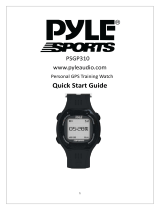
Table of Contents
Getting Started............................................................... 1
Charging the Device................................................................... 1
Keys............................................................................................ 1
Updating the Aviation Database................................................. 1
Pairing Your Smartphone with Your Device............................... 1
Flying............................................................................... 1
Setting the Altitude Alert............................................................. 1
Setting the Barometric Pressure Manually................................. 1
Starting a Flight...........................................................................2
Navigating to the Nearest Airport........................................... 2
Nearest Airport.................................................................. 2
Navigating to an Airport by Its Identifier................................. 2
Horizontal Situation Indicator................................................. 2
Stopping Navigation............................................................... 2
Disabling the Automatic Flight Timer..................................... 2
Activities......................................................................... 2
Starting an Activity...................................................................... 2
Stopping an Activity.................................................................... 2
Skiing.......................................................................................... 2
Going Downhill Skiing or Snowboarding................................ 2
Viewing Your Ski Runs......................................................3
Running...................................................................................... 3
Going for a Run......................................................................3
Using the Metronome.............................................................3
Biking.......................................................................................... 3
Going for a Ride..................................................................... 3
Swimming................................................................................... 3
Going for a Pool Swim........................................................... 3
Swim Terminology.............................................................3
Stroke Types..................................................................... 4
Resting During Pool Swimming.........................................4
Training with the Drill Log..................................................4
Locating a Lost Mobile Device.................................................... 4
Training........................................................................... 4
Setting Up Your User Profile.......................................................4
Fitness Goals......................................................................... 4
About Heart Rate Zones........................................................ 4
Setting Your Heart Rate Zones......................................... 4
Heart Rate Zone Calculations........................................... 5
About Lifetime Athletes.......................................................... 5
Setting Your Power Zones..................................................... 5
Activity Tracking..........................................................................5
Turning On Activity Tracking.................................................. 5
Using the Move Alert..............................................................5
Turning on the Move Alert................................................. 5
Auto Goal............................................................................... 5
Sleep Tracking....................................................................... 5
Using Automated Sleep Tracking......................................5
Using Sleep Mode............................................................. 5
Workouts.....................................................................................5
Following a Workout From the Web.......................................6
Starting a Workout................................................................. 6
About the Training Calendar.................................................. 6
Using Garmin Connect Training Plans.............................. 6
Interval Workouts........................................................................ 6
Creating an Interval Workout................................................. 6
Starting an Interval Workout.................................................. 6
Stopping an Interval Workout.................................................6
Using Virtual Partner®................................................................ 6
Setting a Training Target............................................................ 6
Cancelling a Training Target.................................................. 7
Racing a Previous Activity.......................................................... 7
Personal Records....................................................................... 7
Viewing Your Personal Records
............................................ 7
Restoring a Personal Record................................................. 7
Clearing a Personal Record................................................... 7
Clearing All Personal Records............................................... 7
Running Dynamics......................................................................7
Training with Running Dynamics........................................... 7
Color Gauges and Running Dynamics Data.......................... 8
Tips for Missing Running Dynamics Data.............................. 8
About VO2 Max. Estimates.........................................................8
Getting Your VO2 Max. Estimate for Running....................... 8
Getting Your VO2 Max. Estimate for Cycling......................... 8
Viewing Your Predicted Race Times..................................... 9
Recovery Advisor........................................................................9
Turning On the Recovery Advisor.......................................... 9
Viewing Your Recovery Time.................................................9
About Training Effect.................................................................. 9
Widgets........................................................................... 9
Viewing Widgets......................................................................... 9
Time and Date............................................................................ 9
Altimeter....................................................................................10
Compass...................................................................................10
Temperature............................................................................. 10
Music Controls.......................................................................... 10
Weather.................................................................................... 10
Calendar................................................................................... 10
Notifications.............................................................................. 10
METAR..................................................................................... 10
VIRB Remote............................................................................ 11
Controlling a VIRB Action Camera.......................................11
Clock.............................................................................. 11
Setting an Alarm....................................................................... 11
Starting the Countdown Timer.................................................. 11
Using the Stopwatch................................................................. 11
Setting Sunrise and Sunset Alerts............................................ 11
Navigation..................................................................... 11
Saving Your Location............................................................... 11
Editing Your Saved Locations.................................................. 11
Navigating to a Destination....................................................... 11
Navigating with Sight 'N Go...................................................... 11
Compass...................................................................................11
Map........................................................................................... 11
Panning and Zooming the Map............................................ 12
Navigating To Your Starting Point............................................ 12
Altimeter and Barometer........................................................... 12
History........................................................................... 12
Using History............................................................................ 12
Viewing Your Time in Each Heart Rate Zone...................... 12
Viewing Step Totals.................................................................. 12
Viewing Data Totals.................................................................. 12
Deleting History........................................................................ 12
Using the Odometer..................................................................12
Connect IQ Features.................................................... 12
Downloading Connect IQ Features.......................................... 13
Downloading Connect IQ Features Using Your Computer....... 13
Connected Features..................................................... 13
Enabling Bluetooth Notifications............................................... 13
Viewing Notifications............................................................ 13
Managing Notifications.........................................................13
Turning Off Bluetooth Technology....................................... 13
Turning On and Off Bluetooth Connection Alerts................ 13
Garmin Connect........................................................................13
Using Garmin Connect Mobile............................................. 14
Manually Uploading Data to Garmin Connect Mobile..... 14
Using Garmin Connect on Your Computer.......................... 14
Table of Contents i

























